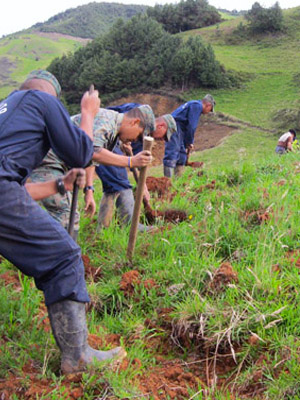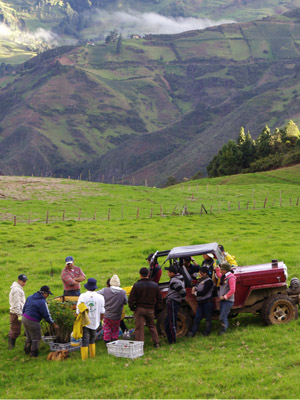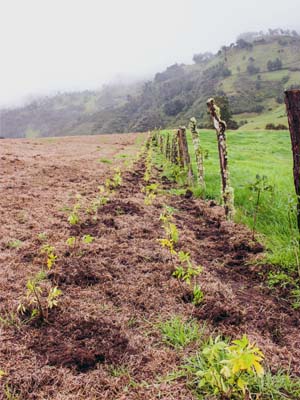




Silvopastoral Techniques

Traditional cattle ranching in high-elevation tropical ecosystems presents a direct threat to the conservation of a range of environmental services that are important to society: water that is steady in volume and low in sediment, carbon sequestration, scenic value, and biodiversity, to name a few. Furthermore, when we consider that cattle husbandry occupies 26% of the planet's land surface, and that in places like Latin America it's a primary driver of deforestation, it is imperative that we identify sustainable models for intensifying production in areas apt for ranching, and revert lands that are less than optimal for ranching back to their native vegetation cover.
Problem Context
For centuries in Latin America, cattle ranchers have relied on a type of grazing based on grass monocultures with no trees. Generally, this management style demands forest exploitation and conversion to pastures. This up-front investment is usually followed by additional investment in grass maintenance: during an initial period such pastures are highly productive, but rapid degradation is characteristic of these areas in a well-known cycle resulting in the abandonment of unproductive pastures and thus the advance of the ranching frontier. On top of the environmental problems caused by this type of management, rancher incomes tend to decrease rapidly following initial investment, trapping them in a constant cycle of poverty and incentivizing them to exploit ever more forest to return to the higher levels of productivity experienced at the outset.
Silvopastoral Systems
Ranching management can be improved with the integration of silvopasture systems. A silvopasture system incorporates trees, shrubs, and other plants, primarily those suitable as alternative cattle forage, within pastures. These plants provide better nutrition for cattle compared with an exclusively graminoid diet.
Fundación Cordillera Tropical's in situ trials demonstrate that there are three primary silvopasture techniques appropriate for the southern Ecuadorian mountains: (i) dispersed trees in pastures, (ii) living fences, wind-breaks, and hedges, and (iii) multi-species forage banks.
The selection of woody species is very important to the success of a silvopasture system in the Andes. Due to cattle nutritional needs, species selection is biased toward trees and shrubs that produce forage and fruits, next toward those that fix nitrogen, and/or timber species the landowner could harvest in future.
Silvopasture systems improve grass productivity, milk and meat production, while at the same time offering benefits for biodiversity, water regulation, and carbon sequestration. An example of this is the Hacienda El Hatico in Colombia, where silvopasture systems were phased in between 1996 and 2003. Implementation included planting 10,000 forage trees and 5-30 timber trees per hectare. As a result, milk production increased from 7,436 to 18,486 litres per hectare per year, and animal carrying capacity from 3.35 to 5.04 cows per hectare (Calle, Z. et al., 2012). At the same time, the proprietor was able to discontinue using pesticides, herbicides, and irrigation systems, and began selling organic milk at a better price than before the change-over. Results are comparable across multiple cases of silvopasture system adoption in Colombia, Costa Rica, Nicaragua, Panama, and Mexico.
Along with production improvements, silvopasture systems contribute to soil and biodiversity conservation as well as carbon sequestration. Such systems increase the number of native plant species present in pastures, which improves habitat availability for a host of species of birds, butterflies, and other animals. Indeed, silvopasture elements often form wildlife corridors connecting patches of native habitat through otherwise inhospitable and uncrossable environments. As an example, the case of Quindío, Colombia could be sited, where at the beginning of silvopasture system conversion a baseline census was conducted, detecting 146 species of birds in one participating property; four years later, 196 bird species were detected, with an important increase in the presence of migratory species, birds who depend on forest ecosystems, and the recolonization of the area by an endangered bird species. It has also been shown that the planting of trees can sequester between 1.2 to 6.1 tons of carbon per hectare per year. Few studies exist measuring the impact of silvopasture systems on the hydrologic cycle and erosion, but preliminary observations suggest that the presence of trees enhances superficial runoff infiltration, and decreases erosion rates.
Creating Demonstration Parcels
En 2014, la Fundación Cordillera Tropical estableció cuatro bancos de forraje, cada uno de 0,5 hectareas, dónde se sembró 3.000 árboles en colaboración con propietarios locales. Los sistemas silvopastoriles incorporan árboles y arbustos dentro del potrero para diversificar la oferta alimentaria, bajar la evapotranspiración en el pasto, y brindar una gama de servicios ambientales a la sociedad: secuestro de carbono, creación de corredores del hábitat, y restauración/recuperación del ciclo hídrico, entre otros. Durante esta fase piloto, la Fundación Cordillera Tropical sembró especies de tilo o sauco blanco (Sambucus spp.) y cáñaro (Erythrina edulis) dentro y alrededor de potreros. Cáñaro es nativa y sauco es naturalizada de la Sierra Ecuatoriana y el ganado las puede consumir.
Se inició un programa de monitoreo de crecimiento y supervivencia en las parcelas. Durante esta fase piloto, la Fundación Cordillera Tropical está investigando el efecto de los siguientes atributos sobre el crecimiento y supervivencia de los árboles: (i) la aplicación en la siembra de abono y cal vs. no abono y cal; (ii) estacas vs. plántulas del vivero; (iii) fertilización vs. no fertilización post-siembra; y (iv) sombra vs. no sombra.
Spanish-language Technical Sheets
FCT has committed to making data from this initiative available for interested researchers and project implementers. Below please find Spanish-language technical sheets that are in development and will be shared with professionals and property owners. We invite your feedback.
¿Para qué sembrar una parcela? (Benefits to adopting silvopastoral techniques)
Preparación y diseño de la Parcela (Preparation and design of a silvopastoral plot)
Mantenimiento de la Parcela (How to maintain a silvopastoral plot)
Técnicas Silvopastoriles para Utilizar en la Sierra Ecuatoriana (Silvopastoral techniques for use in the Ecuadorian Andes)
Houkal, D. and C. Schloegel. 2016. Preliminary Results of a Biomass Study of Elderberry (Sambucus spp.) for Use as Supplemental Cattle Forage in the Highlands of Southern Ecuador. Fundación Cordillera Tropical. Cuenca, Ecuador. 45 pgs. Download: Attachments
Schloegel, Catherine, Laura Lojano, Stuart White, y Dana Houkal. 2015. Manual de Implementación para el programa de Acuerdos de Conservación en las subcuencas altas de los ríos Mazar y Dudas. Fundación Cordillera Tropical: Cuenca, Ecuador.Siembra de árboles en Sangay. (17 de agosto 2014). Diario El Tiempo Seccion 3A. Cuenca, Ecuador. Retrieved November 5, 2015 from http://www.eltiempo.com.ec/noticias-cuenca/147942-siembra-de-a-rboles-en-sangay/
Forestación sirve de modelo sostenible para el pastoreo en el Parque Nacional Sangay (19 julio 2015). Diario El Universo. Retrieved November 5, 2015 from:
http://www.eluniverso.com/vida-estilo/2015/07/19/nota/5024722/forestacion-sirve-modelo-sostenible-pastoreo